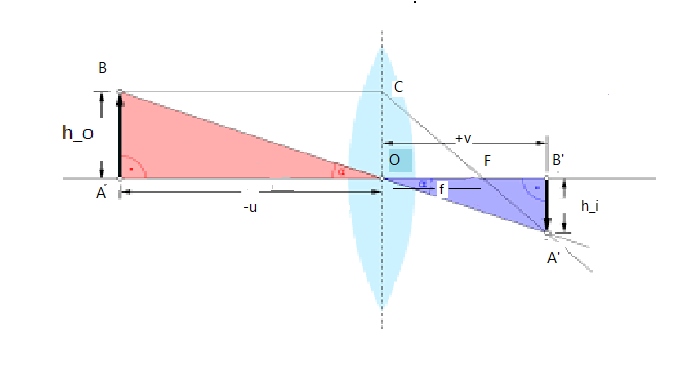
Answer
472.2k+ views
Hint: Lens formula is the relationship between the distance of an object $u$, distance of image $v$ and the focal length of the lens $f$. This law can be used for both concave and convex lenses with appropriate sign conventions. Using similarity of triangles we can prove the following.
Formula used: $\dfrac{1}{v}-\dfrac{1}{u}=\dfrac{1}{f}$
Complete step-by-step answer:
Lens formula is the relationship between the distance of an object $u$, distance of image $v$ and the focal length of the lens $f$. This law can be used for both concave and convex lenses with appropriate sign conventions. The thickness of the lens is neglected.
Lens formula: $\dfrac{1}{v}-\dfrac{1}{u}=\dfrac{1}{f}$
The diagram below shows the formation of a real, inverted and diminished image of \[\text{AB}\]. Where \[\text{AB}\] is placed beyond the center of curvature.

Here object distance $OB =-u$, image distance $OB\prime=+v$ and focal length $OF=f$
Clearly $\Delta ABO \cong \Delta A\prime B\prime$
Therefore $\dfrac{A\prime B\prime}{AB}=\dfrac{OB\prime}{OB}$
Also $\Delta ABF \cong \Delta OCf$
Therefore $\dfrac{A\prime B\prime}{OC}=\dfrac{FB\prime}{OF}$, but $OC=AB$
Then, $\dfrac{A\prime B\prime}{AB}=\dfrac{FB\prime}{OF}$
Therefore $\dfrac{A\prime B\prime}{AB}=\dfrac{OB\prime}{OB}=\dfrac{FB\prime}{OF}$
$\dfrac{OB\prime}{OB}=\dfrac{FB\prime}{OF}= \dfrac{OB\prime-OF}{OF}$
Substituting using sign conventions
$\dfrac{v}{-u}=\dfrac{v-f}{f}$
$vf=-uv+uf $ or $uv=f(u-v)$
Dividing both sides by $uvf$
$\dfrac{uv}{uvf}=\dfrac{fu}{uvf}-\dfrac{fv}{uvf}$
$\dfrac{1}{f}=\dfrac{1}{v}-\dfrac{1}{u}$
Additional Information:
The formula is called the thin lens formula or Lensmaker’s equation. This is used to make commercial lenses such as magnifying glasses and spectacles.
To identify the nature of the object, like magnification, magnification equation is used which states $M=\dfrac{Height\; of \;image}{Height\; of \;object}=-\dfrac{distance\; of\; image}{distance\; of\; object}$ if $M=+$ then the image is magnified and if $M=-$ then image is diminished.
Note:
The thickness of the lens is neglected. Be aware of the sign conventions and the triangles selected. Remember how is lens law defined and its formula $\dfrac{1}{f}=\dfrac{1}{v}-\dfrac{1}{u}$. The formula can be used for any lens and when the object is placed is anywhere on the principal axis.
Formula used: $\dfrac{1}{v}-\dfrac{1}{u}=\dfrac{1}{f}$
Complete step-by-step answer:
Lens formula is the relationship between the distance of an object $u$, distance of image $v$ and the focal length of the lens $f$. This law can be used for both concave and convex lenses with appropriate sign conventions. The thickness of the lens is neglected.
Lens formula: $\dfrac{1}{v}-\dfrac{1}{u}=\dfrac{1}{f}$
The diagram below shows the formation of a real, inverted and diminished image of \[\text{AB}\]. Where \[\text{AB}\] is placed beyond the center of curvature.

Here object distance $OB =-u$, image distance $OB\prime=+v$ and focal length $OF=f$
Clearly $\Delta ABO \cong \Delta A\prime B\prime$
Therefore $\dfrac{A\prime B\prime}{AB}=\dfrac{OB\prime}{OB}$
Also $\Delta ABF \cong \Delta OCf$
Therefore $\dfrac{A\prime B\prime}{OC}=\dfrac{FB\prime}{OF}$, but $OC=AB$
Then, $\dfrac{A\prime B\prime}{AB}=\dfrac{FB\prime}{OF}$
Therefore $\dfrac{A\prime B\prime}{AB}=\dfrac{OB\prime}{OB}=\dfrac{FB\prime}{OF}$
$\dfrac{OB\prime}{OB}=\dfrac{FB\prime}{OF}= \dfrac{OB\prime-OF}{OF}$
Substituting using sign conventions
$\dfrac{v}{-u}=\dfrac{v-f}{f}$
$vf=-uv+uf $ or $uv=f(u-v)$
Dividing both sides by $uvf$
$\dfrac{uv}{uvf}=\dfrac{fu}{uvf}-\dfrac{fv}{uvf}$
$\dfrac{1}{f}=\dfrac{1}{v}-\dfrac{1}{u}$
Additional Information:
The formula is called the thin lens formula or Lensmaker’s equation. This is used to make commercial lenses such as magnifying glasses and spectacles.
To identify the nature of the object, like magnification, magnification equation is used which states $M=\dfrac{Height\; of \;image}{Height\; of \;object}=-\dfrac{distance\; of\; image}{distance\; of\; object}$ if $M=+$ then the image is magnified and if $M=-$ then image is diminished.
Note:
The thickness of the lens is neglected. Be aware of the sign conventions and the triangles selected. Remember how is lens law defined and its formula $\dfrac{1}{f}=\dfrac{1}{v}-\dfrac{1}{u}$. The formula can be used for any lens and when the object is placed is anywhere on the principal axis.
Recently Updated Pages
10 Examples of Evaporation in Daily Life with Explanations

10 Examples of Diffusion in Everyday Life

1 g of dry green algae absorb 47 times 10 3 moles of class 11 chemistry CBSE

What is the meaning of celestial class 10 social science CBSE

What causes groundwater depletion How can it be re class 10 chemistry CBSE

Under which different types can the following changes class 10 physics CBSE

Trending doubts
Fill the blanks with the suitable prepositions 1 The class 9 english CBSE

Which are the Top 10 Largest Countries of the World?

How do you graph the function fx 4x class 9 maths CBSE

Who was the leader of the Bolshevik Party A Leon Trotsky class 9 social science CBSE

The Equation xxx + 2 is Satisfied when x is Equal to Class 10 Maths

Differentiate between homogeneous and heterogeneous class 12 chemistry CBSE

Difference between Prokaryotic cell and Eukaryotic class 11 biology CBSE

Which is the largest saltwater lake in India A Chilika class 8 social science CBSE

Ghatikas during the period of Satavahanas were aHospitals class 6 social science CBSE




